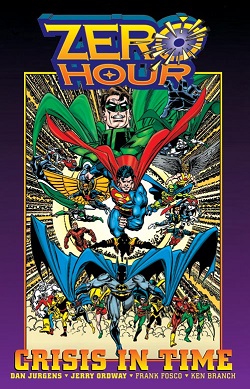This article has multiple issues. Please help improve it or discuss these issues on the talk page . (Learn how and when to remove these messages)
|
| Zero Hour: Crisis in Time! | |
|---|---|
 Cover of the Zero Hour: Crisis in Time trade paperback, art by Dan Jurgens. | |
| Publication information | |
| Publisher | DC Comics |
| Schedule | Weekly |
| Format | Limited series |
| Publication date | September 1994 |
| No. of issues | 5 |
| Main character | DC Universe |
| Creative team | |
| Created by | Dan Jurgens Jerry Ordway |
| Written by | Dan Jurgens |
| Penciller | Dan Jurgens |
| Inker | Jerry Ordway |
| Letterer | Gaspar Saladino |
| Colorist | Gregory Wright |
| Editor | K.C. Carlson |
| Collected editions | |
| Zero Hour: Crisis in Time | ISBN 1563891840 |
"Zero Hour: Crisis in Time!" is a comic book crossover storyline published by DC Comics in 1994, consisting of an eponymous five-issue limited series written and drawn by Dan Jurgens and a number of tie-in books. [1]
Contents
- Background
- Plot
- Aftermath
- Tie-in issues
- Series ending with Zero Hour
- Series rebooted during Zero Hour
- Series launched following Zero Hour
- Zero Month
- Booster Gold #0 (2008)
- 30th Anniversary Special
- In other media
- Collected editions
- References
- External links
In the storyline, Hal Jordan, a member of the intergalactic police force known as the Green Lantern Corps, goes mad with grief after the destruction of his home town of Coast City during the "Reign of the Supermen!" storyline and attempts to destroy and remake the DC Universe after having obtained immense power as Parallax. The issues of the limited series were numbered in reverse order, beginning with issue #4 and ending with #0. [1] The crossover involved almost every DC Universe monthly series published at the time.
